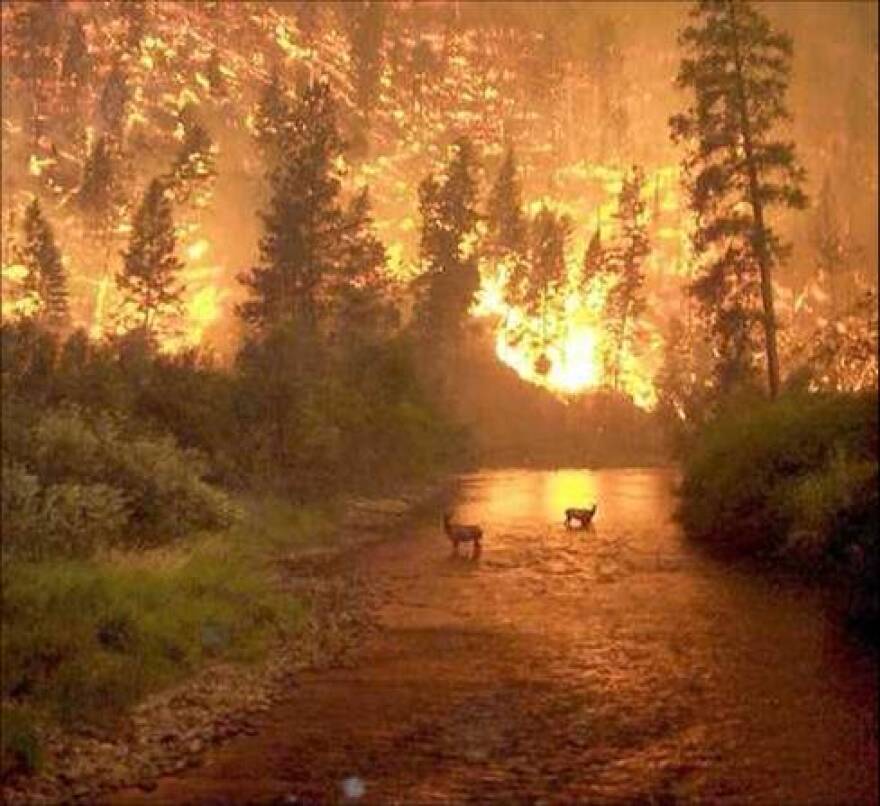Recently on the Almanac, Peter Cullen noticed he hasn't seen many bears in the mountains of New Mexico this year.
Bears are foragers, and Cullen says the lack of piñon, oak and juniper trees caused them to head down to mountain towns looking for thrown-away leftovers.
That got us thinking about our bear populations here in western Colorado.
Though the San Luis Valley doesn’t have the largest bear population in the state, they're still around, and if you think back to this summer after the massive West Fork Fires, it's not hard to imagine bears and other wildlife wandering lost and hungry in the charred remains of beetle-killed trees.
But as Wildlife Biologist Stephanie Ferrero tells it, wildlife aren't nearly as scared of fire as we are. She points to a bear that Colorado Parks & Wildlife researchers tracked during a fire near Pagosa Springs a couple years ago.
"One of these bears that was near the Durango area ended up heading quite a few miles away to go investigate a fire," she says.
That bear's a good example of how wildlife respond much differently to fires than humans.
Before and after the West Fork fires plagued the Rio Grande and San Juan National Forests, Ferrero and other researchers studied the movement of elk with radio collars.
"What we were finding is that the elk stayed in general within that area, even with the burn going on," Ferrero says.
Wildlife generally don't run from fires, instead they just gravitate towards safe pockets of trees that aren't burning. Parks & Wildlife spokesman Randy Hampton says fires are actually a good thing for wildlife. They're essentially nature's way of cleaning out the refrigerator. The flames clear up overgrown vegetation and give animals better access to food.
"When a fire moves through and clears out some of those older berry bushes, and new ones spring up to replace them, you actually get more forage for bears," Hampton says.
Leftover, mineral-rich ash acts like a fertilizer in the soil. New bushes can spring up with sweeter, larger berries, very enticing for bears in particular. Fires also clear out overgrown tree canopies and open the ground up to more sunlight. Grasses can start growing in places where they didn't before.
"Now think about that from an elk's perspective," Hampton says. "If you're an elk that relies on grazing along, that grass is important."
Ferrero says those newer, more abundant food sources can also encourage population growth in some species, or at least resilience. She says there were quite a few elk calves and fawns around when the West Fork Fires hit.
"All summer long they were able to forage on this new growth that was available to them, and that gives them much better chances as they go into winter to be able to survive," she says.
"It's been a phenomenal season so far for hunters. They've been able to find so many more elk, and the elk have really keyed in on the new forage that's been produced because of this fire."
Ferrero says these observed benefits of fire show the need for regular, small-scale controlled burns. This summer's fires in southwestern Colorado burned so hot because the fuel there had been building up for decades.
"That's what causes the damage, is when we're not able to kind of replicate what nature normally does," she says.
But doing those targeted burns is easier said then done, especially when you're dealing with increased home development in forest areas already prone to wildfires.
"To get all the permits approved and to burn at just the right time, it is getting to be more of a challenge," Ferrero says.
Randy Hampton says the growing complexity of dealing with fires from the human perspective is a relatively new problem.
"It really wasn't until the 1980s that we were capable of, or had the need to, put out these large fires."
But he says while fire is perhaps a growing problem for us, you can't necessarily say the same for wildlife. Hampton cites a massive fire that burned around three million acres across the West in the early 20th century.
"Wildlife survived the great fire of 1910," he says. "Bears and all the other critters survived pretty darn well long ago before we were putting fires out and worrying about 'em."



